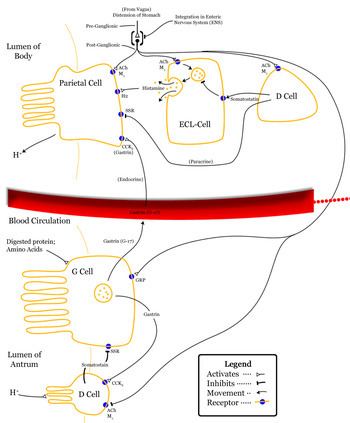Aliases GAST, GAS, gastrin Ensembl ENSG00000184502 | Entrez 2520 | |
 | ||
External IDs OMIM: 137250 MGI: 104768 HomoloGene: 628 GeneCards: GAST | ||
Control of the gi tract the roles of gastrin cck secretin motilin and gastric inhibitory peptide
Gastrin is a peptide hormone that stimulates secretion of gastric acid (HCl) by the parietal cells of the stomach and aids in gastric motility. It is released by G cells in the pyloric antrum of the stomach, duodenum, and the pancreas.
Contents
- Control of the gi tract the roles of gastrin cck secretin motilin and gastric inhibitory peptide
- The hormone gastrin
- Genetics
- Synthesis
- Release
- Function
- Gastric lumen
- Paracrine
- Nervous
- Circulation
- Role in disease
- History
- References
Gastrin binds to cholecystokinin B receptors to stimulate the release of histamines in enterochromaffin-like cells, and it induces the insertion of K+/H+ ATPase pumps into the apical membrane of parietal cells (which in turn increases H+ release into the stomach cavity). Its release is stimulated by peptides in the lumen of the stomach.
The hormone gastrin
Genetics
The GAS gene is located on the long arm of the seventeenth chromosome (17q21).
Synthesis
Gastrin is a linear peptide hormone produced by G cells of the duodenum and in the pyloric antrum of the stomach. It is secreted into the bloodstream. Gastrin is found primarily in three forms:
Also, pentagastrin is an artificially synthesized, five amino acid sequence identical to the last five amino acid sequence at the C-terminus end of gastrin. The numbers refer to the amino acid count.
Release
Gastrin is released in response to certain stimuli. These include:
Gastrin release is inhibited by:
Function
The presence of gastrin stimulates parietal cells of the stomach to secrete hydrochloric acid (HCl)/gastric acid. This is done both directly on the parietal cell and indirectly via binding onto CCK2/gastrin receptors on ECL cells in the stomach, which then responds by releasing histamine, which in turn acts in a paracrine manner on parietal cells stimulating them to secrete H+ ions. This is the major stimulus for acid secretion by parietal cells.
Along with the above-mentioned function, gastrin has been shown to have additional functions as well:
Gastric lumen
Paracrine
Nervous
Circulation
Role in disease
In the Zollinger–Ellison syndrome, gastrin is produced at excessive levels, often by a gastrinoma (gastrin-producing tumor, mostly benign) of the duodenum or the pancreas. To investigate for hypergastrinemia (high blood levels of gastrin), a "pentagastrin test" can be performed.
In autoimmune gastritis, the immune system attacks the parietal cells leading to hypochlorhydria (low stomach acidity). This results in an elevated gastrin level in an attempt to compensate for increased pH in the stomach. Eventually, all the parietal cells are lost and achlorhydria results leading to a loss of negative feedback on gastrin secretion. Plasma gastrin concentration is elevated in virtually all individuals with mucolipidosis type IV (mean 1507 pg/mL; range 400-4100 pg/mL) (normal 0-200 pg/mL) secondary to a constitutive achlorhydria. This finding facilitates the diagnosis of patients with this neurogenetic disorder. Additionally, elevated gastrin levels may be present in chronic gastritis resulting from H pylori infection.
History
Its existence was first suggested in 1905 by the British physiologist John Sydney Edkins, and gastrins were isolated in 1964 by Roderic Alfred Gregory at the University of Liverpool. In 1964 the structure of Gastrin was determined.
